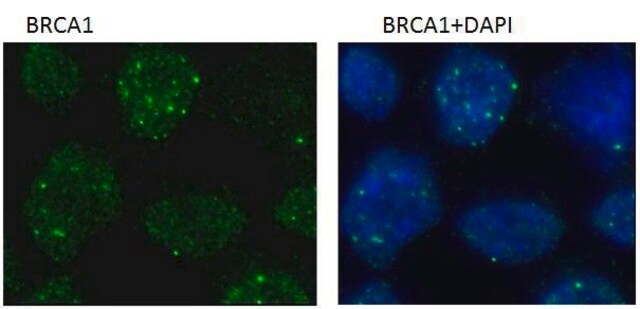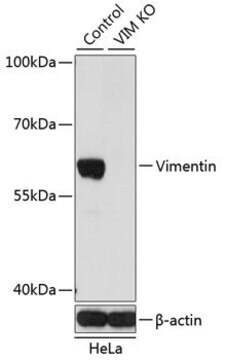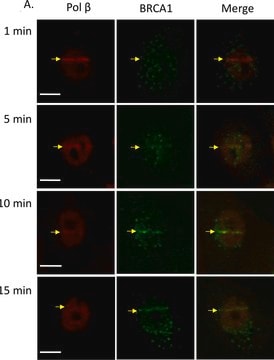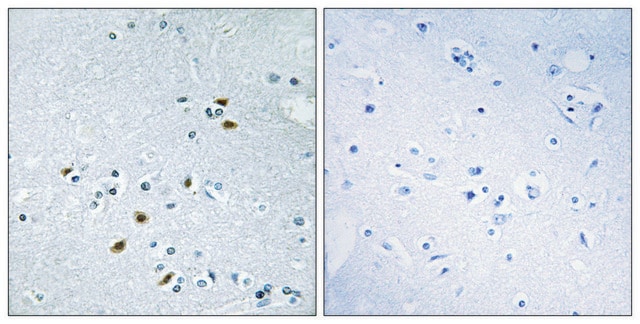일반 설명
We are committed to bringing you greener alternative products, which adhere to one or more of The 12 Principles of Green Chemistry.This antibody is Preservative-free, produced without the harm or sacrifice of animals and exceptionally stable to allow for ambient shipping and storage if needed and thus aligns with "Waste Prevention", "Designing Safer Chemicals" and "Design for Energy Efficiency".
Click here for more information.
ZooMAb® antibodies represent an entirely new generation of recombinant monoclonal antibodies.
Each ZooMAb® antibody is manufactured using our proprietary recombinant expression system, purified to homogeneity, and precisely dispensed to produce robust and highly reproducible lot-to-lot consistency. Only top-performing clones are released for use by researchers. Each antibody is validated for high specificity and affinity across multiple applications, including its most commonly used application. ZooMAb® antibodies are reliably available and ready to ship when you need them.
특이성
Clone ZooMAb® Rabbit recombinant monoclonal antibody that specifically detects BRCA1. It targets an epitope within 22 amino acids from the C-terminal region.
면역원
KLH-conjugated linear peptide corresponding to 22 amino acids from the C-terminal region of human Breast cancer type 1 susceptibility protein (BRCA1).
애플리케이션
Quality Control Testing
Evaluated by Western Blotting in SK-BR-3 cell lysate.
Western Blotting Analysis (WB): A 1:1,000 dilution of this antibody detected BRCA1 in SK-BR-3 cell lysate.
Tested applications
Western Blotting Analysis: A 1:1,000 dilution from a representative lot detected BRCA1 in NIH3T3 cell lysate.
Immunohistochemistry (Paraffin) Analysis: A 1:100 dilution from a representative lot detected BRCA1 in human testis tissue sections.
Affinity Binding Assay:: A representative lot of this antibody bound BRCA 1 with a KD of 9.5 x 10-10 in an affinity binding assay.
Immunocytochemistry Analysis: A 1:100 dilution from a representative lot detected BRCA1 in MCF7 cells.
Note: Actual optimal working dilutions must be determined by end user as specimens, and experimental conditions may vary with the end user
표적 설명
Breast cancer type 1 susceptibility protein (UniProt: P38398; also known as EC:2.3.2.27, RING finger protein 53, RING-type E3 ubiquitin transferase BRCA1) is encoded by the BRCA1 (also known as RNF53) gene (Gene ID: 672) in human. BRCA1 and BRCA2 are important in maintaining genomic stability by promoting efficient and precise repair of double-strand breaks. BRCA1 is expressed in all cells and plays a broader role in various cellular processes in response to DNA damage. It promotes the protection of nascent DNA at stalled replication forks independently of the canonical BRCA1-PALB2 interaction. Its recruitment to DNA damage sites is mediated by ABRAXAS1 and the BRCA1-A complex. BRCA1 contains two BRCT domains (aa 1642-1736 and 1756-1855) that recognize and bind phosphorylated pSXXF motif on proteins. The interaction with the phosphorylated pSXXF motif of ABRAXAS1 recruits BRCA1 at DNA damage sites. BRCA1 is reported to exist as a heterodimeric complex with BARD1, a structurally related protein that also contains a N-terminal RING-finger domain and two C-terminal BRCT motifs. This heterodimer regulates the localization and loading of RAD51 at break sites through PALB2-BRCA2. Their association is mediated through their respective RING domains, and together they exhibit E3 ubiquitin ligase activity, which can be disrupted by mutations within the RING domain of BRCA1. BRCA1 and BARD1 are shown to be phosphorylated at residues that are located close to the site of interaction between BARD1 and RAD51 (Ser148 on BARD1 and Ser114 on BRCA1) and Ser114 phosphorylation promotes BRCA1 interaction with PIN1. PIN1 increases interactions between the BRCA1-BARD1 complex and RAD51 resulting in recruitment of RAD51 to stalled replication forks and enhance protection of the nascent DNA strand. Cells lacking BRCA1 show defects in DNA repair by homologous recombination. Mutations in BRCA1 gene have been linked to breast and ovarian cancers. A vast majority of inherited breast cancers result from mutations in the BRCA 1 gene. Male subjects with BRCA1 mutations exhibit about 3-fold increase in risk of prostate cancer. This ZooMAb® recombinant monoclonal antibody, generated by our propriety technology, offers significantly enhanced specificity, affinity, reproducibility, and stability over conventional monoclonals. (Ref.: Daza-Martin, M., et al. (2019). Nature. 571(7766); 521-527; Gudumundsdottir, K., and Ashworth, A. (2006). Oncogene 25; 5864-5874).
물리적 형태
Purified recombinant rabbit monoclonal antibody IgG, lyophilized in PBS, 5% Trehalose, normal appearance a coarse or translucent resin. The PBS/trehalose components in the ZooMAb formulation can have the appearance of a semi-solid (bead like gel) after lyophilization. This is a normal phenomenon. Please follow the recommended reconstitution procedure in the data sheet to dissolve the semi-solid, bead-like, gel-appearing material. The resulting antibody solution is completely stable and functional as proven by full functional testing. Contains no biocide or preservatives, such as azide, or any animal by-products. Larger pack sizes provided as multiples of 25 μL.
재구성
300 μg/mL after reconstitution at 25 μL per vial. Please refer to guidance on suggested starting dilutions and/or titers per application and sample type.
저장 및 안정성
Recommend storage of lyophilized product at 2-8°C; Before reconstitution, micro-centrifuge vials briefly to spin down material to bottom of the vial; Reconstitute each vial by adding 25 μL of filtered lab grade water or PBS; Reconstituted antibodies can be stored at 2-8°C, or -20°C for long term storage. Avoid repeated freeze-thaws.
법적 정보
ZooMAb is a registered trademark of Merck KGaA, Darmstadt, Germany
면책조항
Unless otherwise stated in our catalog or other company documentation accompanying the product(s), our products are intended for research use only and are not to be used for any other purpose, which includes but is not limited to, unauthorized commercial uses, in vitro diagnostic uses, ex vivo or in vivo therapeutic uses or any type of consumption or application to humans or animals.









